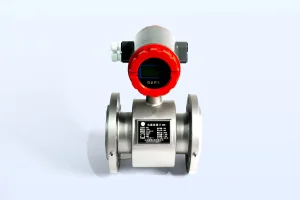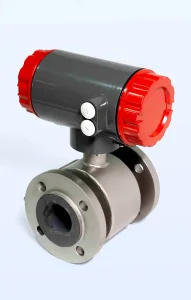
When you handle water supplies in homes, offices, or factories, picking the best water flow meter can really affect how well things run. It impacts exactness and costs over time. A water flow meter is a tool that checks the amount or speed of water flowing in a pipe. This info is key for charging fees, spotting leaks, controlling processes, and following rules.
The relative indication error E of the water meter shows up as a percent. This points out how vital exactness is in every use. If you track water use in an apartment building or watch fluid output in a factory, you need to know the flow rate within okay limits. That way, you keep things accountable. It also helps systems work better.
Water meters show up in many areas. In homes, they watch personal use for right billing. In business spots like office buildings or malls, they help make the most of resources. Factories use them to control steps and meet eco rules.
Electromagnetic flow meters rely on Faraday’s law of electromagnetic induction. They can check most liquids that conduct electricity. That includes water, with or without bits like solids. They handle sewage, sludge, mud, or paste too. This wide fit makes electromagnetic meters very useful in fields like waste water cleanup, power making, and chemical work.
You have a few kinds of meters based on what you need.
These include mechanical meters, like rotary piston or Woltman type. There are also ultrasonic meters. And electromagnetic meters round out the list.
Out of these, electromagnetic flow meters catch the eye. They offer flexibility and good exactness. The measuring channel in an electromagnetic flow meter is a smooth straight tube. It has no parts that block the flow for detection. So, they clog less often. They also need little upkeep.
Exactness matters a lot when you pick a water meter. Think about the top flow rate in normal work conditions. At that rate, the meter runs fine. The reading error stays in the allowed range. This usual flow rate, called Q3, has to fit your planned setup. That gives you steady readings.
Some meters add pushback. That causes pressure drop. But electromagnetic ones do not create pressure loss from flow checking. They work great if you must keep pressure steady in the system.
Fluid conductivity needs to be more than 5 μS/cm. Tap water and raw water run about 100-500 μS/cm. If your liquid dips below that, like oil products, electromagnetic meters might not fit.
Steady temperature counts as well. Liner Temperature Range: Standard: -20°C to +90°C. High-Temp, like PTFE: -30°C to +180°C. Pick a type that fits your work temps. That keeps performance even.
If you want solid water measuring tools from pros in the field, look at Shandong Chen Shuo. They have years in fluid tools. This firm gives smart electromagnetic flow meters for many uses. These go from city water lines to factory pipes. Their items mix top exactness with strong builds. They also add easy smart links.
An electromagnetic flow meter has no moving bits inside. So, there is no pressure loss while measuring. This setup cuts down on wear. It boosts how long it lasts.
Linear Measurement: The sparked voltage matches flow speed. It gives high exactness, from 0.5% to 1.0%. These tools give sure results. They hold up even when things change a lot.
No Block: Zero pressure drop, low upkeep. This keeps the system going without stops. It saves on extra power bills too.

If you need a small design that still does well, the Electromagnetic Flowmeter DN50 fits the bill.
Nominal Diameter: DN10–DN3000, and you can tweak it. It adapts to different pipe sizes. The small flange setup makes putting it in easy. It works in tight spots.
This type suits city water pipes or local watering setups just right. There, medium flows get close watch. You do not need big changes to the setup.
To make it clearer, think about an apartment block. Water comes in through one main line. The DN50 meter sits there. It tracks how much each unit uses. Bills come out fair. No one pays extra for leaks they did not cause. In small buildings, it saves space under sinks or in utility rooms. For farms, irrigation lines stay neat. You measure water for crops without bulky gear. This keeps costs down and use smart.
For big jobs like plants or city setups with more water, try the Electromagnetic Flowmeter DN100.
It takes speeds up to 15 m/s. You can pick liners like PTFE or rubber for fighting chemicals. Corrosion Resistance: Custom liners, such as rubber or PTFE. And electrodes like 316L, titanium, or tantalum. This setup deals with tough liquids with ease.
It checks flow both ways. That helps in setups that switch directions. It works for power counting or hand-off checks. In a factory, say one that makes drinks, the DN100 goes on big pipes. It watches water for mixing or cleaning. Readings stay true, even if bits float in the water. For city water works, it tracks main lines. That spots waste fast. In big spots like hospitals, it ensures steady supply. No drops in pressure mean smooth days.
Small types like DN50 give good exactness. They take little room. That suits apartments or tiny groups. Space for install is short, but bill exactness stays key.
In a home setup, picture a family home with a garden. The DN50 fits the outdoor tap line. It measures hose use. You see if sprinklers waste water. Costs drop on the bill. For renters, it means fair shares. No fights over who used more.
Mid places gain from types that take okay flows. They link easy to building controls. Use MODBUS or RS485 ways. Many electromagnetic units from this maker have that.
Take a mall. Water goes to fountains and restrooms. The meter balances loads. It spots high use in peak hours. Managers adjust. Savings add up yearly.
In tough spots like power spots or waste cleanup plants, you need strong gear. Cases in power work show electromagnetic flow meters have top exactness. They keep steady over time. These traits make them must-haves for watch under hard setups.
In a chemical plant, acids flow fast. The meter stands up. It logs data round the clock. Alarms ping for odd flows. That cuts downtime. Safety goes up too.
Make sure it fits your pipe sizes, like DN50 to DN100. Check pressure levels too. Pressure Ratings: 1.6 MPa or 4.0 MPa. They should match your system’s push.
Before you buy, walk the site. See where it goes. Is it wet? Hot? Measure pipes twice. A wrong fit means redo work. That costs time and cash.
Smart bits like HART protocol let it join auto controls easy. Smart Functions: Empty pipe alarm, remote talk via HART or RS485.
Link it to your computer setup. Data flows live. You graph trends. Fix issues before they grow.
Check that the item meets local rules. This covers drink water or waste watch needs.
Look for seals from bodies like NSF or ISO. They prove it is safe and true. Skipping this risks fines or shutdowns.
Shandong Chen Shuo earned its name by giving strong fixes in many fields. From power lines to food plants, they deliver. These perks make electromagnetic water meters a top pick for now water checks. Their list lets tweaks for liquid kind, pipe size, heat hold—even electrode stuff. It fits your needs spot on. Plus, their team of pros guides you from pick to put-in. You get help every step. No guesswork.
What sets them apart? Years in the game mean real know-how. They test in labs and fields. Products last longer. Support comes quick—phone, email, or site chat. Users say installs go smooth. One factory boss noted less leaks after swap. Bills dropped 15%. Stories like that build trust.
If you fix an old meter setup or start new, you can rely on custom help from pros. They know specs and daily hassles. Hit up their site contact now. Get tips just for your spot.
Q: How do I know which size of electromagnetic water meter I need?
A: First, find your pipe size, like DN50 or DN100. Then, note low and high flows you expect. Match them to item specs. Look at Q3/Q1 ratio. A turn down like R100 means Q3/Q1=100.
Q: Can I use an electromagnetic meter with non-conductive liquids?
A: No. It does not work for non-conductive liquids. Make sure the liquid conducts over 5 μS/cm first.
Q: Will installing an electromagnetic meter affect my pipeline pressure?
A: Not at all. It does not make pressure loss from flow check. The inside lets fluid go free, no blocks.